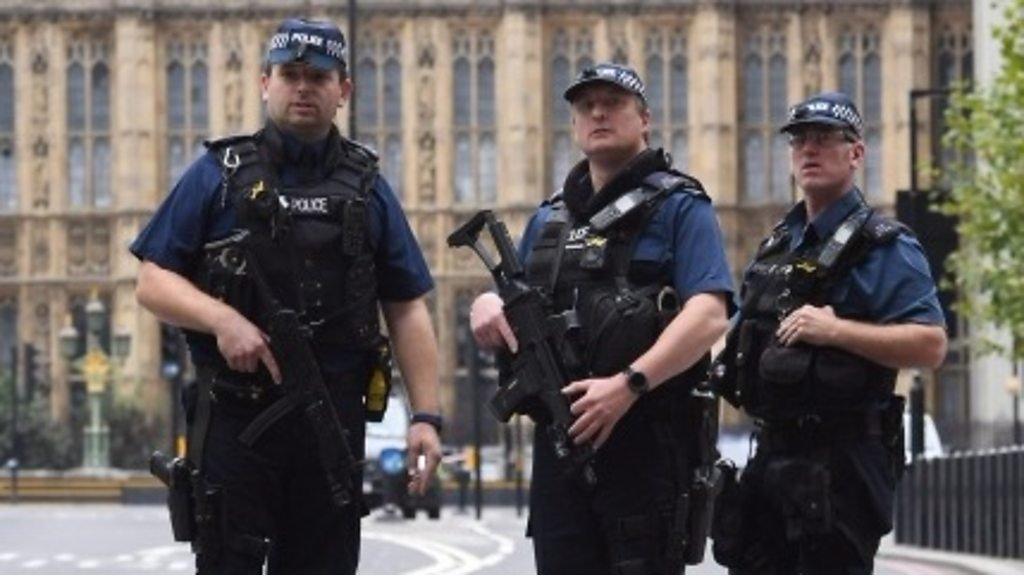Westminster car crash: Man arrested on suspicion of terror offences
- Published
The car can be seen crashing into a barrier
A man has been arrested on suspicion of terrorism offences after a car crashed outside the Houses of Parliament.
The vehicle swerved into cyclists and pedestrians shortly after 07:30 BST, injuring three people.
The 29-year-old suspect is not believed to be known to MI5 or counter-terrorism police, and is not co-operating with officers. Searches are taking place in Birmingham and Nottingham.
Two people were treated in hospital for their injuries but discharged.
Scotland Yard's head of counter terrorism Assistant Commissioner Neil Basu said, external: "Given that this appears to be a deliberate act, the method and this being an iconic site, we are treating it as a terrorist incident."
He added there was "no intelligence at this time of further danger" to London or the UK as a whole.
No-one else was in the car and no weapons have been found.
The government held a meeting of its Cobra emergency committee and the prime minister has paid tribute to the "formidable courage" and professionalism of the emergency services who "ran towards a dangerous situation in order to protect the public".
Urging the public to remain vigilant but "carry on as normal", Theresa May added: "For the second time in as many years the home of our democracy, which is a potent symbol of our precious values of tolerance and freedom, has witnessed terrible scenes just yards from its door."
The suspect, who has not been formally identified, is being held at a south London police station and the vehicle is being searched.
Sources say he is from the Birmingham area.
Security Minister Ben Wallace told the BBC the suspect was British but originally from another country.

The suspect, on the right of the image, can be seen being taken away by police
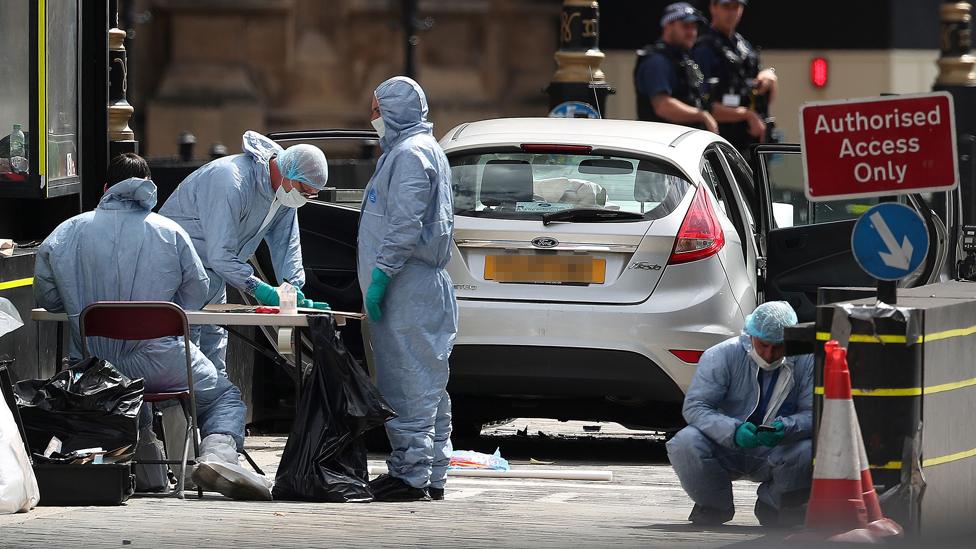
Only the area around the scene of the crash remains sealed off
A number of eyewitnesses have said the silver Ford Fiesta, which was travelling westbound in Parliament Square, appeared to deliberately hit members of the public as it swerved into the opposite lane.
Footage released by the BBC shows the moment when the car then crosses over a traffic island in the middle of the road before crashing into the security barriers. A police officer can be seen jumping over another barrier to get out of the way.
Police have released more details about the car's movements before the crash:
The car travelled from Birmingham to London on Monday night, arriving in the capital just after midnight
The vehicle was in the Tottenham Court Road area from approximately 01:25 BST until 05:55. It was then driven around the Westminster and Whitehall area from approximately 06:00 until the incident
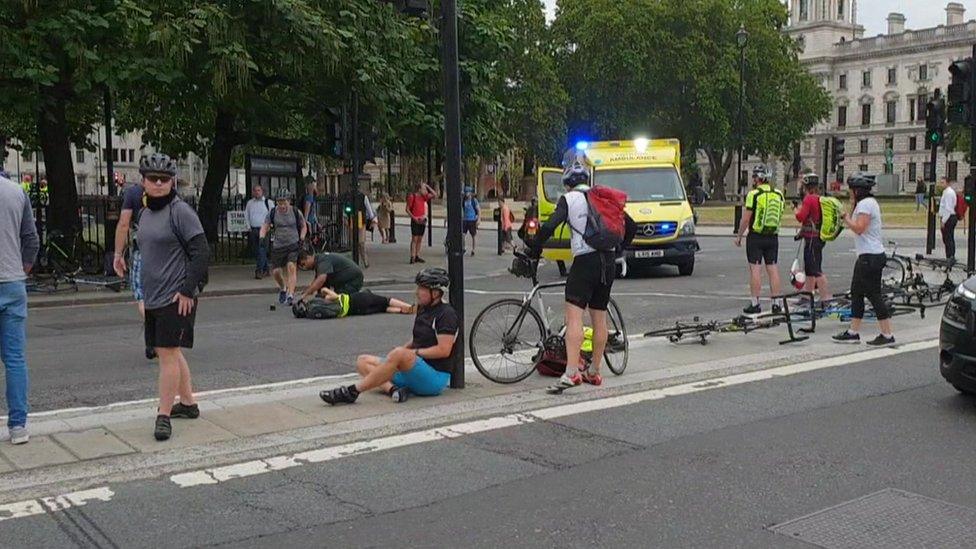
Cyclists were seen on the ground after the crash
Westminster Tube station was closed for entry and exit, and streets around Millbank and Parliament Square cordoned off for several hours after the crash.
The immediate area around the incident remains taped off and screened by white temporary fencing.
Parliament is not currently sitting.
Did you witness the incident? Please email haveyoursay@bbc.co.uk, external
Neil Basu says it appears to have been a deliberate act
A man and a woman were taken to hospital and later discharged, while a third person with minor injuries was assessed at the scene.

'I ran for my life' - eyewitness accounts
Witness: "I saw a man drive towards Parliament at speed"
Barry Williams, a BBC member of staff based at Millbank, said: "I heard lots of screams and turned round.
"The car went on to the wrong side of the road to where cyclists were waiting at lights and ploughed into them.
"Then it swerved back across the road and accelerated as fast as possible, and hit the barrier at full pelt.
"He hit it at such speed the car actually lifted off the ground and bounced.
"Then the police just jumped. Two officers managed to leap over the security barriers and then the armed police vehicles all sped towards the scene."
Another witness, called Kirsty, said: "A car drove the wrong way round the road, drove through about 20 cyclists and crashed."
Jason Williams told BBC Radio 4's Today programme the driver had "driven at speed - more than 40 mph".
He added: "There was smoke coming out of the car...
"I saw at least 10 people lying down. I was told basically to move away, to run. I have run for my life."
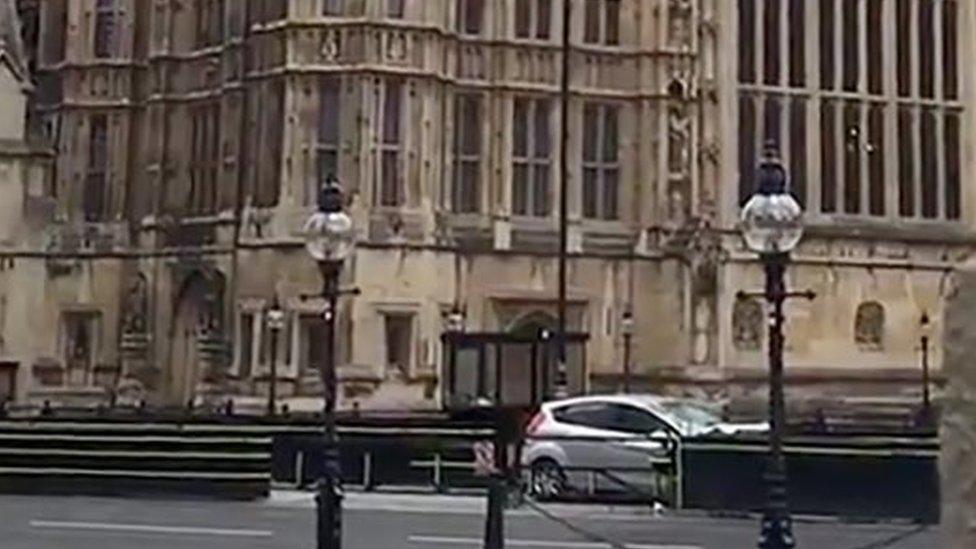
Eyewitness Ewalina Ochab took this picture shortly after the crash
Ewalina Ochab, who also saw the crash, said: "I think it looked intentional - the car drove at speed and towards the barriers."
She said: "I was walking on the other side of the road. I heard some noise and someone screamed. I turned around and I saw a silver car driving very fast close to the railings, maybe even on the pavement."

Armed police responded after a vehicle crashed into security barriers
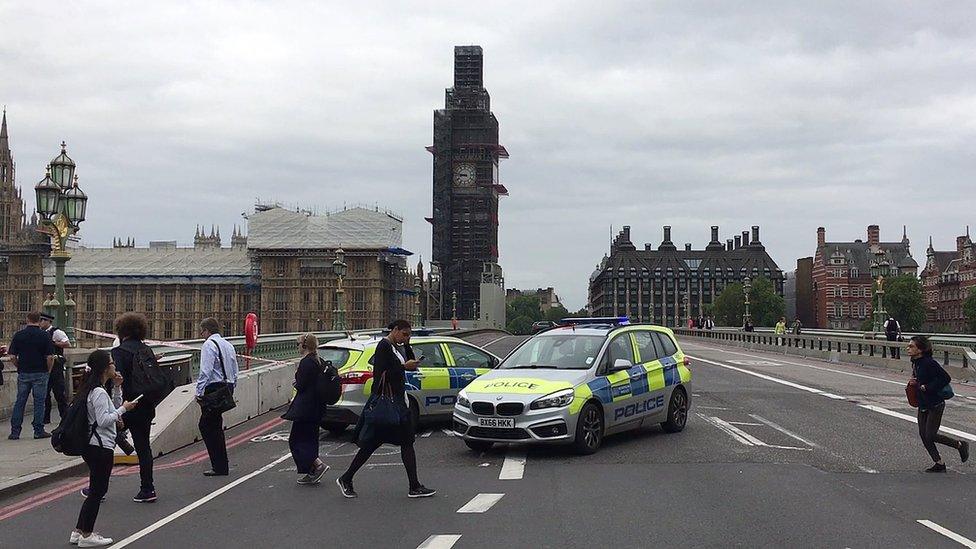
The area around the Houses of Parliament was sealed off
More than 10 police vehicles and at least three ambulances were at the scene outside Parliament - where firearms officers and police sniffer dogs searched the area.
British Transport Police said it was increasing patrols in England, Scotland and Wales and that its officers would be "highly visible on trains and at stations".
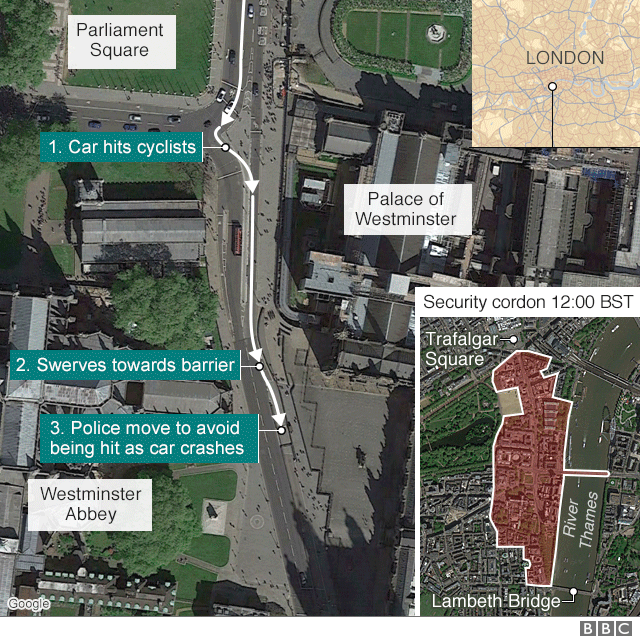

Analysis
By Dominic Casciani, BBC News home affairs correspondent
Security arrangements at Parliament have progressively tightened since 2001. In the aftermath of the 7/7 attacks, new truck bomb-proof barriers were installed in an effort to "target harden" Westminster.
These include the reinforced low black rampart-like walls that surround Parliament itself and a highly visible armed police presence.
Visitors need to go through a chicane-like system designed to help armed officers spot suspects. The one significant weak spot was the main vehicle gates - as became apparent in March 2017's one-man attack.
That triggered an internal security review that has led to changes that remain secret - although it's apparent to Londoners that there are now more armed police than ever before patrolling the area.
The threat of terrorism is a constant concern for Parliamentarians - it's not new. The IRA murdered Airey Neave MP in 1979 in a car bomb that exploded within the palace grounds. And the dilemma remains the same: how best to balance security with guaranteeing that the heart of British democracy remains open to the people.

Home Secretary Sajid Javid expressed his gratitude to the emergency services.
Allow X content?
This article contains content provided by X. We ask for your permission before anything is loaded, as they may be using cookies and other technologies. You may want to read X’s cookie policy, external and privacy policy, external before accepting. To view this content choose ‘accept and continue’.

Mayor of London Sadiq Khan said he was in close contact with police and that he "utterly condemns all acts of terrorism on our city".
And Labour leader Jeremy Corbyn said the bravery of emergency services "keeps us safe day in, day out".
US President Donald Trump responded to the incident on Twitter, external, saying: "Another terrorist attack in London... These animals are crazy and must be dealt with through toughness and strength!"
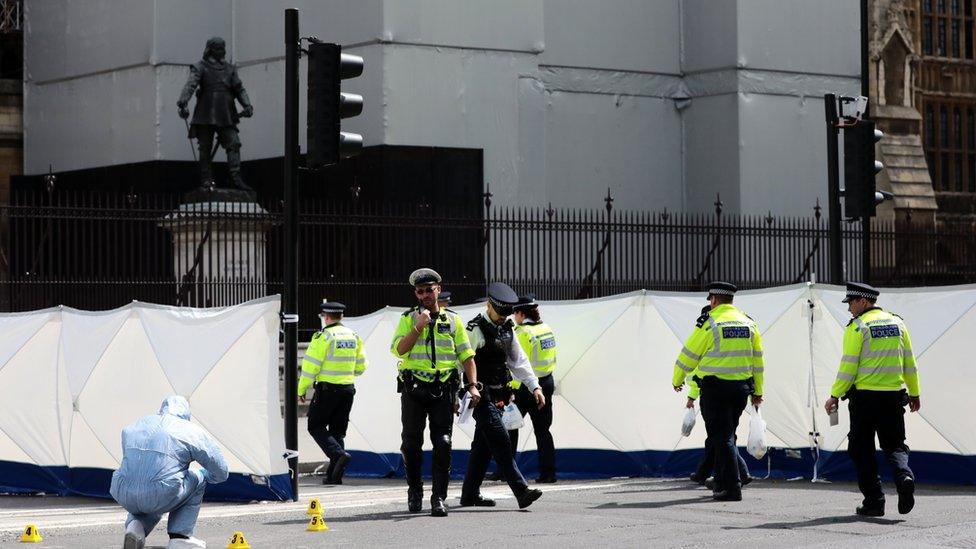
Forensics officers could be seen at the scene
The Houses of Parliament are surrounded with security barriers of steel and concrete. The measures were extended in the wake of the Westminster Bridge attack in March 2017 when Khalid Masood ploughed a car into crowds on Westminster Bridge, killing four people.
The Prime Minister's Official Spokesman said as of the end June 2018 there were 676 live investigations into potential terrorist plots.
He said since March 2017, 13 Islamist plots and four far-right plots had been foiled.
Scotland Yard is asking anyone with information on Tuesday's crash to call 0800 789 321. Anyone with video or pictures of the crash is asked to send them to police, external.
- Published14 August 2018
